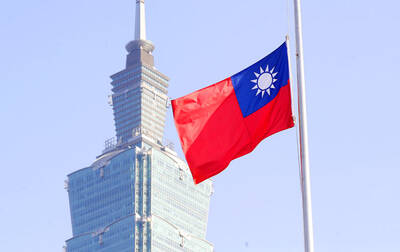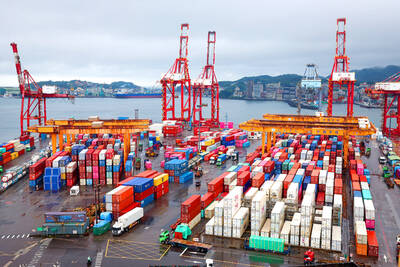The Singapore Exchange (SGX) welcomes Taiwanese companies to list on its mainboard and newly transformed second board, Cata-list, an exchange official said in Taipei yesterday.
"Singapore is the most internationalized market in Asia [and] can serve Taiwanese businesses as a highly effective platform for raising capital," Lawrence Wong (黃良穎), an SGX executive vice president, told a media briefing yesterday.
Wong said that the Singapore Exchange, established in 1999, was a fast-growing market with 757 publicly listed companies and a market capitalization of US$467 billion as of January.
Nearly 38 percent of the city-state's listed companies are foreign firms, including 138 firms from China, 54 from Hong Kong, 53 from other Southeast Asian states and 19 from Taiwan.
Wong said SGX was particularly interested in wooing "fast-growing" Taiwanese companies to list on its second board, Catalist, where listings can be facilitated in five to six weeks -- compared with 12 to 18 weeks for the mainboard.
Catalist, formerly known as SESDAQ, has no financial and operational thresholds for listing, Wong said, adding that the only requirement is an endorsement from one of the applicant's appointed sponsors.
Singapore may be famous as one of the region's financial hubs, but the Taiwan Stock Exchange (TSE) is still the best choice for Taiwanese companies, more so if the government could scrap restrictions on capital flow, said Hwang Min-juh (
"The 40 percent capital cap on publicly traded Taiwanese companies investing in China is the only reason for them to list elsewhere, such as Hong Kong and Singapore," said Hwang, who is also chairman of SinoPac Securities Corp (
Taiwan bans listed companies from investing more than 40 percent of their capital in China.
Companies seeking to succeed in Singapore must be familiar with the market there and have a highly recognizable brand name or reputation to attract local investors -- half of which are institutional investors, he said, adding that the TSE outpaces the SGX in terms of daily turnover.
Wong said two Taiwanese firms had recently exited the SGX, including Want Want Corp (
The TSE is also actively courting Taiwanese firms based overseas to list on the local bourse.
The local exchange sponsored a "2008 Taiwanese Enterprises Symposium," hosted by its chairman Wu Rong-i (吳榮義), in Ho Chi Minh City, Vietnam, where Taiwanese companies are among the leading manufacturers with investments totaling more than US$10 billion.
Wu said he believed the TSE would outperform its Asian peers once listing restrictions were further eased and the political uncertainty associated with the presidential election was cleared up.

ELECTRONICS BOOST: A predicted surge in exports would likely be driven by ICT products, exports of which have soared 84.7 percent from a year earlier, DBS said DBS Bank Ltd (星展銀行) yesterday raised its GDP growth forecast for Taiwan this year to 4 percent from 3 percent, citing robust demand for artificial intelligence (AI)-related exports and accelerated shipment activity, which are expected to offset potential headwinds from US tariffs. “Our GDP growth forecast for 2025 is revised up to 4 percent from 3 percent to reflect front-loaded exports and strong AI demand,” Singapore-based DBS senior economist Ma Tieying (馬鐵英) said in an online briefing. Taiwan’s second-quarter performance beat expectations, with GDP growth likely surpassing 5 percent, driven by a 34.1 percent year-on-year increase in exports, Ma said, citing government

‘REMARKABLE SHOWING’: The economy likely grew 5 percent in the first half of the year, although it would likely taper off significantly, TIER economist Gordon Sun said The Taiwan Institute of Economic Research (TIER) yesterday raised Taiwan’s GDP growth forecast for this year to 3.02 percent, citing robust export-driven expansion in the first half that is likely to give way to a notable slowdown later in the year as the front-loading of global shipments fades. The revised projection marks an upward adjustment of 0.11 percentage points from April’s estimate, driven by a surge in exports and corporate inventory buildup ahead of possible US tariff hikes, TIER economist Gordon Sun (孫明德) told a news conference in Taipei. Taiwan’s economy likely grew more than 5 percent in the first six months

SMART MANUFACTURING: The company aims to have its production close to the market end, but attracting investment is still a challenge, the firm’s president said Delta Electronics Inc (台達電) yesterday said its long-term global production plan would stay unchanged amid geopolitical and tariff policy uncertainties, citing its diversified global deployment. With operations in Taiwan, Thailand, China, India, Europe and the US, Delta follows a “produce at the market end” strategy and bases its production on customer demand, with major site plans unchanged, Delta president Simon Chang (張訓海) said on the sidelines of a company event yesterday. Thailand would remain Delta’s second headquarters, as stated in its first-quarter earnings conference, with its plant there adopting a full smart manufacturing system, Chang said. Thailand is the firm’s second-largest overseas

SUPPLY RESILIENCE: The extra expense would be worth it, as the US firm is diversifying chip sourcing to avert disruptions similar to the one during the pandemic, the CEO said Advanced Micro Devices Inc (AMD) chief executive officer Lisa Su (蘇姿丰) on Wednesday said that the chips her company gets from supplier Taiwan Semiconductor Manufacturing Co (TSMC, 台積電) would cost more when they are produced in TSMC’s Arizona facilities. Compared with similar parts from factories in Taiwan, the US chips would be “more than 5 percent, but less than 20 percent” in terms of higher costs, she said at an artificial intelligence (AI) event in Washington. AMD expects its first chips from TSMC’s Arizona facilities by the end of the year, Su said. The extra expense is worth it, because the company is